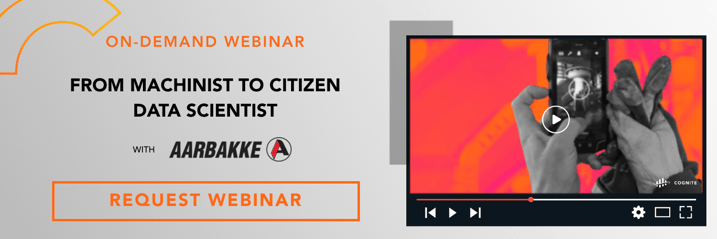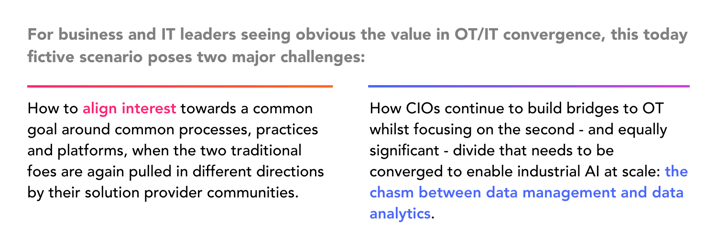
Back in January 2017, Gartner predicted that “by 2020, 50 percent of OT service providers will create key partnerships with IT-centric providers for IoT offerings.” In August 2020, this remains a stretch goal at best.
Whilst the business case for the convergence of OT (operational technology) with IT (information technology) remains as strong as ever — and limited OT/IT partnerships have indeed been announced — the OT market’s focus seems to lie with strengthening its hold on OT through supplier consolidation rather than building bridges that extend to encompass and engage IT communities, roles and value. Recent headlines such as “Aveva Is in Exclusive Talks to Buy SoftBank-Backed OSIsoft” and“ Honeywell and Halliburton Team Up” offer characteristic guidance.
Meanwhile in July 2020, leading strategy advisory firm BCG argued that “Digital Acceleration Is Just a Dream Without a New Approach to Tech”. Making a strong case for data liberation, rapid time to value and digital transformation at scale through direct business user empowerment, their guidance can be summarised into “liberating data from the IT core and giving the business side unparalleled access and tools to combine data in new and differentiating ways — companies can create flywheels of innovation.” This BCG calls a data and digital platform (DDP).
Unfortunately BCG’s definition of “tech” remains restricted to “IT tech” in scope — despite the majority of digital transformation of industries being reliant on OT tech at both the source (pending data liberation) and the destination (pending data activation). This withstanding, a new approach to tech is very much needed. Moreover, this new approach needs to focus on contextual awareness of the data, not merely its liberation “from the IT core”. Context — the direct and indirect relationships and metadata that turn ‘dumb data’ into meaningful information — can only be unlocked by connecting OT with IT. Liberated data without full OT/IT context remains largely worthless, resulting in organizations drowning in data, but starving for insights — no matter where the raw data resides or who has access to it.
As for liberating data, as a first step before contextualization, focus needs to be on data liberation from the OT core as opposed to “from the IT core”.
Advances across technologies make OT/IT convergence more possible than ever
OT/IT convergence is not about turning IT pros into plant engineers or machine operators into data scientist — although the latter is indeed happening regardless or OT/IT convergence — but about executing on a strategy to align and bring together formerly isolated SMEs, cultures, data and platforms deployed by OT and IT teams to improve operational performance through unified goals and KPIs. This can, of course, happen through the adoption of a new data and digital platform that contextually fuses OT and IT data, making this contextualized data conveniently available to a growing audience of data consumers, both inside the enterprise and across its partner ecosystem.

Timing to execute on OT/IT convergence has never been better. Progressive industrial enterprises are:
-
Adopting DevOps and low code development,
-
Crossing the chasm from PoCs to in-production-at-scale with DataOps,
-
Democratizing access to contextually enriched data with data fabrics with data contextualization, and
-
Realizing operational maintenance and production efficiencies with operational digital twins.
The only dark cloud on the OT/IT convergence horizon is the trend towards centralization of suppliers and solutions focusing on OT only.
Silos and consolidations of power — old or new — are the enemy of digital transformation
Playing the devil’s advocate, let's assume the following developments:
![]()
1. Instead of promoting open interfaces and open architectures between OT and IT, we enter an era of significant consolidation on both sides of the OT and /IT divide, resulting in fewer, yet much more consolidated, OEM hardware/software/services juggernauts - in particular on the OT side.
![]()
2. These new juggernauts will focus on traditionally entrenched, highly segregated buyer personas for OT and IT separately, with potential to undo the limited gains towards convergence and collaboration in these departments at industrial enterprises.
![]()
3. The result is less systems and vendor choice, with significantly larger risk of vendor lock-in resulting in single source reliance over time. OT and IT remain separated across SMEs, cultures, data — and platforms.

Openness and a genuine commitment to addressing the needs of both OT and IT professionals is more important now than ever. A new data and digital platform can only succeed on its value promise if it has OT/IT convergence and openness at its core.
Since you’re here, we’d love to hear about your thoughts, successes and challenges with OT/IT convergence at your enterprise. Please reach out to us to join one of our upcoming Virtual Executive Roundtables on the topic to learn and share with peers.
